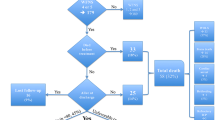Abstract
Background
Although there are extensive data on long-term disability after subarachnoid hemorrhage (SAH), there are few data on the trajectory of functional recovery after hospital discharge.
Methods
From October 2009 to April 2010, we prospectively followed consecutive patients with non-traumatic SAH discharged from a university hospital. Modified Rankin Scale (mRS) scores were calculated at discharge from chart review and at 6 months by standardized telephone interview. Good functional status was defined as a mRS score of 0–2, and poor status as an mRS score of 3–6. Descriptive statistics were used to assess the trajectory of functional recovery and determine the proportion of patients whose functional status improved from poor to good.
Results
Among 52 patients with non-traumatic SAH (79 % aneurysmal) who were discharged alive, most (71 %) were discharged home. Median (IQR) mRS score was 3 (2–4) at discharge and 2 (1–2) at 6 months. Some functional recovery (any improvement in mRS score) was seen in most patients (83 %; 95 % CI, 72–93 %). Of the 28 patients with poor functional status at discharge, 16 (57 %) improved to good functional status at 6 months. All patients with Hunt–Hess grade 4 or 5 hemorrhages (n = 14) had poor functional status at discharge, but half (95 % CI, 20–80 %) recovered to a good functional status at 6 months.
Conclusions
Although our sample size is small, our findings suggest that a substantial proportion of patients with SAH who are disabled at discharge go on to regain functional independence within 6 months.

Similar content being viewed by others
References
Suarez JI, Tarr RW, Selman WR. Aneurysmal subarachnoid hemorrhage. N Engl J Med. 2006;354:387–96.
Nieuwkamp DJ, Setz LE, Algra A, Linn FH, de Rooij NK, Rinkel GJ. Changes in case fatality of aneurysmal subarachnoid haemorrhage over time, according to age, sex, and region: a meta-analysis. Lancet Neurol. 2009;8:635–42.
Al-Khindi T, Macdonald RL, Schweizer TA. Cognitive and functional outcome after aneurysmal subarachnoid hemorrhage. Stroke. 2010;41:e519–36.
Haug T, Sorteberg A, Sorteberg W, Lindegaard KF, Lundar T, Finset A. Cognitive outcome after aneurysmal subarachnoid hemorrhage: time course of recovery and relationship to clinical, radiological, and management parameters. Neurosurgery. 2007;60:649–56.
Springer MV, Schmidt JM, Wartenberg KE, Frontera JA, Badjatia N, Mayer SA. Predictors of global cognitive impairment 1 year after subarachnoid hemorrhage. Neurosurgery. 2009;65:1043–50.
Rinkel GJ, Algra A. Long-term outcomes of patients with aneurysmal subarachnoid haemorrhage. Lancet Neurol. 2011;10:349–56.
Mayer SA, Kreiter KT, Copeland D, et al. Global and domain-specific cognitive impairment and outcome after subarachnoid hemorrhage. Neurology. 2002;59:1750–8.
Hunt WE, Hess RM. Surgical risk as related to time of intervention in the repair of intracranial aneurysms. J Neurosurg. 1968;28:14–20.
Report of World Federation of Neurological Surgeons Committee on a universal subarachnoid hemorrhage grading scale. J Neurosurg. 1988;68:985–986.
Hijdra A, van Gijn J, Nagelkerke NJ, Vermeulen M, van Crevel H. Prediction of delayed cerebral ischemia, rebleeding, and outcome after aneurysmal subarachnoid hemorrhage. Stroke. 1988;19:1250–6.
Kreiter KT, Copeland D, Bernardini GL, et al. Predictors of cognitive dysfunction after subarachnoid hemorrhage. Stroke. 2002;33:200–8.
Meyer B, Ringel F, Winter Y, et al. Health-related quality of life in patients with subarachnoid haemorrhage. Cerebrovasc Dis. 2010;30:423–31.
Yarlagadda S, Rajendran P, Miss JC, et al. Cardiovascular predictors of in-patient mortality after subarachnoid hemorrhage. Neurocrit Care. 2006;5:102–7.
Longstreth WT Jr, Nelson LM, Koepsell TD, van Belle G. Clinical course of spontaneous subarachnoid hemorrhage: a population-based study in King County, Washington. Neurology. 1993;43:712–8.
Roos YB, de Haan RJ, Beenen LF, Groen RJ, Albrecht KW, Vermeulen M. Complications and outcome in patients with aneurysmal subarachnoid haemorrhage: a prospective hospital based cohort study in the Netherlands. J Neurol Neurosurg Psychiatry. 2000;68:337–41.
Navi BB, Kamel H, McCulloch CE, et al. Accuracy of neurovascular fellows’ prognostication of outcome after subarachnoid hemorrhage. Stroke. 2012;43:702–7.
Lowenstein SR. Medical record reviews in emergency medicine: the blessing and the curse. Ann Emerg Med. 2005;45:452–5.
Teasdale G, Jennett B. Assessment of coma and impaired consciousness. A practical scale. Lancet. 1974;2:81–4.
Fisher CM, Kistler JP, Davis JM. Relation of cerebral vasospasm to subarachnoid hemorrhage visualized by computerized tomographic scanning. Neurosurgery. 1980;6:1–9.
van Swieten JC, Koudstaal PJ, Visser MC, Schouten HJ, van Gijn J. Interobserver agreement for the assessment of handicap in stroke patients. Stroke. 1988;19:604–7.
Wunsch H, Gershengorn H, Mayer SA, Claassen J. The effect of window rooms on critically ill patients with subarachnoid hemorrhage admitted to intensive care. Crit Care. 2011;15:R81.
Hop JW, Rinkel GJ, Algra A, van Gijn J. Changes in functional outcome and quality of life in patients and caregivers after aneurysmal subarachnoid hemorrhage. J Neurosurg. 2001;95:957–63.
Mees SM, Algra A, Vandertop WP, et al. Magnesium for aneurysmal subarachnoid haemorrhage (MASH-2): a randomised placebo-controlled trial. Lancet. 2012;380:44–9.
Bruno A, Shah N, Lin C, et al. Improving modified Rankin Scale assessment with a simplified questionnaire. Stroke. 2010;41:1048–50.
Dombovy ML, Drew-Cates J, Serdans R. Recovery and rehabilitation following subarachnoid haemorrhage. Part I: outcome after inpatient rehabilitation. Brain Inj. 1998;12:443–54.
Conflicts of interest
None.
Author information
Authors and Affiliations
Corresponding author
Rights and permissions
About this article
Cite this article
Navi, B.B., Kamel, H., Claude Hemphill, J. et al. Trajectory of Functional Recovery After Hospital Discharge for Subarachnoid Hemorrhage. Neurocrit Care 17, 343–347 (2012). https://doi.org/10.1007/s12028-012-9772-3
Published:
Issue Date:
DOI: https://doi.org/10.1007/s12028-012-9772-3




